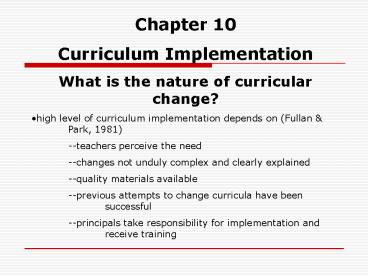Curriculum Implementation - PowerPoint PPT Presentation
1 / 14
Title:
Curriculum Implementation
Description:
teachers have opportunity to share ideas and problems and receive support from ... learning communities-core teaching teams engaging in ongoing discussions related ... – PowerPoint PPT presentation
Number of Views:680
Avg rating:3.0/5.0
Title: Curriculum Implementation
1
Chapter 10 Curriculum Implementation
- What is the nature of curricular change?
- high level of curriculum implementation depends
on (Fullan Park, 1981) - --teachers perceive the need
- --changes not unduly complex and clearly
explained - --quality materials available
- --previous attempts to change curricula have
been successful - --principals take responsibility for
implementation and receive training
2
--teachers have substantial input and staff
development --strong school-board and community
support --careful developed implementation
plan --administrators prevent and respond to
overload of teachers --principals advocate
and support new curriculum --teachers have
opportunity to share ideas and problems and
receive support from supervisors and
administrators
3
- eight local factors affecting implementation
(Corbett Dawson, 1981) - --district priorities
- --availability of incentives
- --availability of resources
- --organizational characteristics
- --the political coalitions present
- --the success of prior projects
- --the local environment
- --the complexity of the change itself
4
- What is the role of a curriculum leader as a
change agent? - change agent-educational program changed to meet
the needs of students to a greater degree - role of change agent
- --developing a shared vision
- --formulating a need assessment
- --developing or selecting an innovation
- --targeting group(s) for the proposed change
- --anticipating problems and resistance to change
- --formulating a plan
5
- --evaluating the implementation plan and making
needed changes - success of a curriculum leader as change agent
depends on - --extent of formulating a shared vision
- --developing a strategic plan of implementation
6
- What is the importance of curriculum leadership
and planning? - four basic questions to be answered for
successful integration of curriculum - --what resources are required?
- --are motives for change focused on student
learning? - --who is the best person to lead initiative?
- --who will be best suited to assess and maintain
curricular programs after implementation? - planning by leadership
- --opens the project to participant view
7
- --should address the who, what, when, where,
why and how aspects of the program - important factors to be considered
- --keep students and teachers needs at
forefront - --provide appropriate support structures for
students and - staff
- --review school programs for classroom
adjustments - --locate relevant research
- --consider possible modifications of practices
and regulations - --examine needed changes in schools philosophy
and mission statement
8
- --if necessary, survey stakeholders for their
viewpoints - --envision what completed project will look like
- components of curricula guidelines and standards
- --leadership and vision
- --educational leaders
- --learning and teaching
- --productivity and professional practice
- --support, management, and operations
9
- What are learning communities and how do they
affect curriculum change? - major concept of learning communities-teachers
need to teach other teachers - more professional autonomy and development of
specific goals for student learning - learning communities-core teaching teams engaging
in ongoing discussions related to best practices
10
- benefits of teachers teaching teachers (Little,
1990) - --higher quality solutions to instructional
problems - --increased confidence among faculty
- --increased ability to support one anothers
strengths and to accommodate weaknesses - --systematic assistance to beginning teachers
- --ability to examine and expand a pool of ideas,
methods and materials
11
- What are the effective components in the
planning, implementation, and institutional
stages of curriculum development? - develop an overall district plan for curriculum
development and improvement - --aligned with NCLB and governmental mandates
- --incorporate a strategy of systematic
incrementalism - --develop a constituency for the planned
curriculum change - --appoint the task force
12
- --determine the pace and scope of change
- --secure the needed resources
- --make specific provisions in securing continued
input from teachers - --anticipate and make the necessary
organizational changes - --develop strategies to incorporate and
implement technology - effective actions in the initiation stage
- --required materials and equipment should be
available and readily accessible - --secure active support of district
administrators, supervisors and school
principals
13
- --secure active support of parents and community
- --monitor teachers use of new curriculum
- effective actions during implementation stage
- --continue providing staff development for
teachers - --increase administrative pressure on teachers
to use the - the new curriculum
- --make provisions for systematic evaluation
- --solve emerging problems
- institutionalization the final stage in the
change process- variables affecting success - --strong and continued administrative commitment
14
--mandated for all teachers --strong
administrative pressure on users to implement
the solution --necessary organizational
changes made --consistent administrative support
for users --continuing assistance by
administrators --increased user effort due to
administrative pressure --increased user effort
increased user commitment































